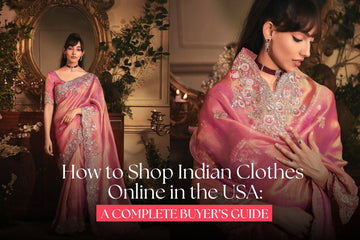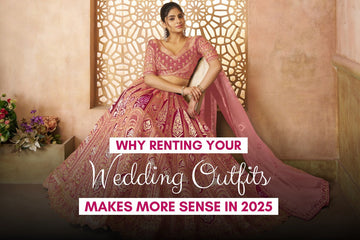Your wedding day is a momentous occasion filled with tradition, culture, and the promise of a new beginning. As a groom, choosing the perfect sherwani is just the beginning of crafting your unforgettable look for the big day. Accessorizing your sherwani thoughtfully can elevate your ensemble from stylish to truly remarkable, adding personality, elegance, and charm. In this guide, we'll delve into the art of accessorizing your sherwani, offering expert tips and insights to help you navigate the myriad of choices available. From selecting the right turban to adding the finishing touches with jewelry and footwear, we'll walk you through every step of the process, ensuring you look and feel your absolute best as you embark on this beautiful journey of love and togetherness
Understanding Sherwani Styles
Sherwanis, quintessential attire for traditional South Asian weddings and formal occasions, come in various styles, each reflecting unique cultural influences and design elements. Classic sherwanis typically feature long, structured silhouettes with intricate embroidery, often embellished with traditional motifs like paisleys or floral patterns. These styles, characterized by their regal elegance, pair well with statement accessories such as ornate turbans, bejeweled brooches, and elaborate footwear like mojaris or juttis.
Contemporary interpretations of the sherwani embrace modern trends while preserving their cultural essence. Slimmer cuts, shorter lengths, and minimalistic embellishments characterize these designs, offering a fusion of traditional aesthetics with a contemporary flair. With such sherwanis, accessory choices tend to lean towards understated elegance, featuring sleek cufflinks, refined watches, and minimalist footwear like loafers or oxfords. Ultimately, the choice of sherwani style influences accessory decisions, dictating whether to opt for opulent embellishments or sleek, minimalist accents to complement the overall look.
Selecting the Right Turban (Pagdi)
The turban, or pagdi, holds significant cultural and religious symbolism in Indian weddings, representing honor, respect, and dignity. It serves not only as a fashion statement but also as a symbol of the wearer's social status, heritage, and spirituality. When selecting the right turban to complement a sherwani, several factors should be considered.
- Firstly, the style of the turban should harmonize with the overall aesthetic of the sherwani. Traditional sherwanis with intricate embroidery and embellishments pair well with grand, voluminous turbans, while contemporary sherwanis may call for sleeker, more streamlined turban styles.
- Secondly, the color of the turban should complement the sherwani while also considering the wearer's skin tone and personal preferences. Opting for complementary or contrasting colors can create visually appealing combinations. For example, a gold or cream turban can enhance the richness of a red or maroon sherwani, while a navy or black turban can provide a sophisticated contrast to lighter-colored sherwanis.
- Lastly, the fabric of the turban should be chosen for its comfort and suitability for the occasion. Silk turbans are a popular choice for weddings due to their luxurious sheen and drape, while cotton or brocade turbans offer breathability and texture. Additionally, considering factors such as weather and climate can help in selecting the most appropriate fabric.
Ultimately, selecting the right turban involves a balance of cultural tradition, personal style, and practical considerations, ensuring that it complements the sherwani and enhances the overall look of the wearer on their special day.
Accessorizing with Jewelry
When accessorizing with jewelry for a sherwani ensemble, the key is to strike a balance between adding sophistication and elegance without overwhelming the overall look. Here's a guide for grooms to choose the right jewelry pieces:
-
Necklaces: Consider opting for a single statement necklace that complements the neckline of the sherwani. A classic choice is a simple gold or silver chain with a pendant, such as a religious symbol or a personalized pendant with the groom's initials. Avoid overly chunky or elaborate necklaces that may distract from the sherwani's design.
-
Brooches: Brooches can add a touch of refinement to the sherwani ensemble. Choose a brooch that matches the color scheme and style of the sherwani. A small, intricately designed brooch pinned at the collar or on the chest can enhance the sherwani without overpowering it. Consider motifs like floral designs or traditional symbols for a timeless appeal.
-
Rings: A single statement ring on the groom's finger can add a touch of elegance to the ensemble. Opt for a ring with a simple yet meaningful design, such as a wedding band with intricate engraving or a gemstone that holds personal significance. Avoid wearing multiple rings on one hand, as it can appear excessive and detract from the overall sophistication of the sherwani ensemble.
-
Cufflinks: If the sherwani has cuffs that allow for cufflinks, choosing the right pair can elevate the look. Opt for cufflinks that complement the color and design of the sherwani. Simple, understated designs with subtle embellishments are ideal for maintaining a polished and sophisticated appearance.
-
Watch: A stylish watch can be a practical and fashionable accessory for the groom. Choose a watch with a classic design and a metal or leather strap that complements the sherwani's color scheme. Avoid oversized or flashy watches that may distract from the elegance of the ensemble.
By selecting jewelry pieces that complement the sherwani's design and color scheme while maintaining a sense of refinement and sophistication, grooms can enhance their wedding attire without overwhelming it. Remember, less is often more when it comes to accessorizing with jewelry for a sherwani ensemble.
Footwear Matters
Footwear plays a crucial role in completing the sherwani look, as it not only adds to the overall aesthetic but also enhances the groom's comfort and confidence on their special day. Traditional footwear options like mojaris or juttis are popular choices that perfectly complement the elegance of the sherwani ensemble. Crafted from leather and adorned with intricate embroidery or embellishments, these traditional shoes exude charm and cultural authenticity.
Mojaris and juttis come in a variety of colors and designs, allowing grooms to choose a pair that coordinates harmoniously with their sherwani. From rich jewel tones to subtle neutrals, there's a wide range of options to suit every preference and style. Additionally, the soft leather construction of these shoes ensures comfort throughout the festivities, making them practical as well as stylish choices.
For those seeking a more modern approach to footwear, there are plenty of contemporary options that complement the sherwani ensemble while adding a touch of sophistication. Sleek leather loafers or oxfords in classic hues like black, brown, or navy provide a polished finishing touch to the groom's attire. These modern shoe options offer both style and comfort, making them versatile choices for weddings and formal occasions.
Ultimately, whether opting for traditional mojaris or juttis or modern shoe options, the key is to select footwear that not only complements the sherwani but also reflects the groom's personal style and preferences. By choosing the right footwear, grooms can complete their sherwani look with confidence and elegance, ensuring a memorable and stylish appearance on their special day.
Adding Elegance with Dupattas
Dupattas, though traditionally associated with women's attire, play a significant role in enhancing the elegance and sophistication of sherwani ensembles for men. When draped thoughtfully, a dupatta can add a touch of regal charm and cultural richness to the groom's attire.
One of the primary functions of the dupatta in sherwani attire is to add layers and dimension to the ensemble. Grooms can drape the dupatta over one shoulder or across both shoulders, depending on personal preference and the style of the sherwani. Additionally, the draping technique can vary based on the occasion and cultural traditions. For instance, for a formal wedding ceremony, a neatly pleated dupatta draped over one shoulder and pinned in place can convey a sense of elegance and refinement, while for a more relaxed event, a casually draped dupatta can lend a touch of effortless sophistication.
When selecting a dupatta for a sherwani ensemble, consider the fabric choice carefully. Luxurious fabrics like silk, chiffon, or brocade are popular options for dupattas, as they offer a lustrous sheen and elegant drape that complements the sherwani's design. Additionally, intricate embroidery, embellishments, or handcrafted details on the dupatta can further enhance its aesthetic appeal and elevate the overall look of the ensemble.
It's essential to coordinate the color and design of the dupatta with the sherwani to ensure a cohesive and harmonious appearance. Whether opting for a matching dupatta that complements the sherwani's color palette or choosing a contrasting dupatta to add visual interest, the goal is to create a balanced and refined look.
Ultimately, by selecting the right fabric, draping technique, and design details, grooms can use dupattas to add elegance and sophistication to their sherwani attire, making a memorable and stylish statement on their special day.


















